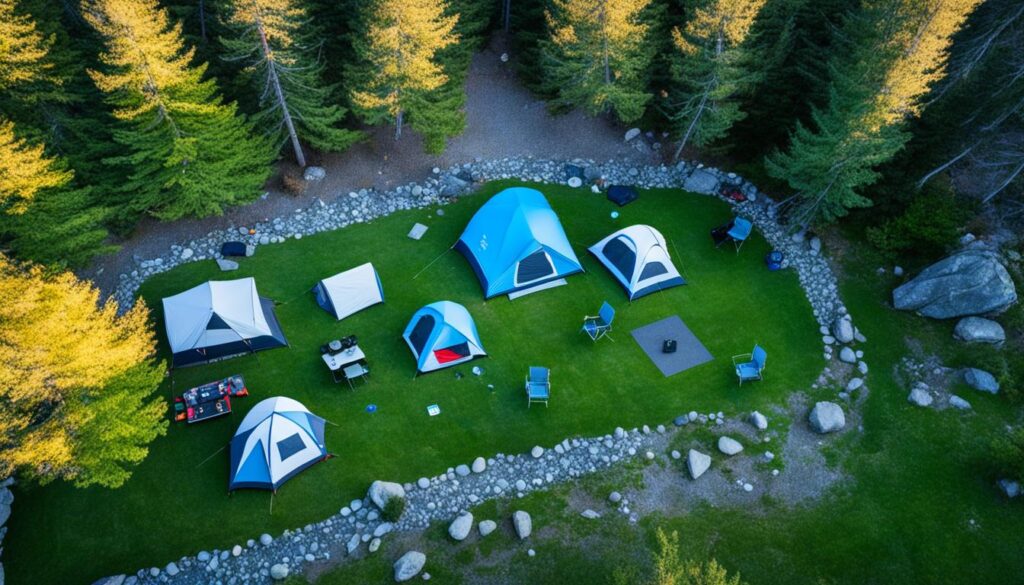As I spread out my worn tent on the rugged ground, I felt a surge of worry. The idea of my tent’s thin base facing such tough ground troubled me. But, I had a tent footprint in my bag – a small but crucial item. It keeps the tent safe from the ground, both protecting it and making it last longer. In the realm of camping gear accessories, the tent footprint is often forgotten. Yet, it plays a key role in the success of your trips.
Key Takeaways
- A tent footprint is a lightweight, waterproof ground cover that protects the bottom of your tent from damage.
- Tent footprints come in various materials like polyethylene, cuben fiber, and oxford nylon to suit different camping conditions.
- They help extend the life of your tent by preventing wear and tear, enhance waterproofing, and make cleaning the tent easier.
- Tent footprints are especially recommended for backpacking tents with thinner, more delicate materials.
- Choosing the right tent footprint depends on factors like your tent’s denier rating and the camping surface conditions.
Understanding Tent Footprints
A tent footprint is a waterproof cover placed under your tent. It protects the bottom from getting damaged. This tent footprint protects your tent from rocks, sticks, and sharp ground objects.
Definition and Purpose
The tent footprint is the first layer set on the ground at the campsite. It acts as a barrier between your tent floor and the ground. Using a tent groundsheet can make your camping gear last longer. This means you won’t need to repair or replace it as often.
Types of Materials Used
Tent footprints are made of waterproof materials like polyethylene, cuben fiber, oxford nylon, or polyester. These materials protect your tent from the wet or rough ground. So, your tent stays dry and safe.
Do You Really Need a Tent Footprint?
While tent footprints aren’t a must, they have several upsides. They shield the tent bottom from damage, which is great on rough grounds. This keeps your tent in good shape longer, saving you money on buying a new one.
Protecting Your Tent Floor
Lightweight tents can easily snag on sharp objects on the ground. A tent groundsheet protects your tent from these risks. It’s like a shield that keeps your tent safe, reducing the chance of it tearing or ripping.
This means you won’t have to replace your tent as often. It’s a smart way to care for your camping gear.
Enhancing Waterproofing
A waterproof tarp for tents also boosts your shelter’s water resistance. It keeps dampness from the ground out, helping you stay dry. This is key in rainy weather.
Minimizing Cleaning Efforts
Cleaning up after camping is easier with a tent footprint. It traps dirt and mud, keeping your tent cleaner. So, when it’s time to go, you can leave the campsite with less hassle.
Factors to Consider When Choosing a Tent Footprint
When picking a tent footprint, thinking about several key things is really important. One main thing to consider is the denier rating of your tent floor. Denier shows how thick and strong the threads of the fabric are. More denier means the material is tougher.
Tent Floor Denier Rating
Tents with low denier floors, like those in ultralight backpacking models, can get easily torn up by rough camping surfaces. A solid tent footprint or groundsheet can really help. It’s best to choose a footprint with the same danier or even tougher than your tent’s floor. This adds protection and makes your camping gear last longer.
Camping Surface Conditions
Think about the ground you will be camping on when selecting a tent footprint. If your campsites are often rocky or uneven, a thicker, more waterproof tarp for tents is a must. It stops your tent floor from getting holes. For softer, flatter ground, you can get by with a lightweight tent footprint.
what is a tent footprint
Tent footprints vary in cost and weight, making your choice important. Branded footprints, costing $30 to $80, can add weight. This is something to keep in mind for your camping gear.
Cost and Weight Considerations
But, if you want to save money or pack lighter, you have other options. Many stores sell generic tent footprints. They’re made of tough materials like polyethylene or polyester and are much cheaper than brand names.
Some campers get creative by making their own. They use water-resistant tarps or light ground cloths. This DIY method can save lots of money.
Custom vs. DIY Options
Making your own tent footprint lets you customize it to your needs. You can make a perfect campsite ground protection for your tent. It’s a great way to get what you want without paying a lot for brand-name accessories.
Using a Tent Footprint Properly
Using a tent footprint is simple, with a couple of key points to remember. Firstly, choose a clean, level spot when setting up. This area should be free of any sharp objects. Lay the lightweight tent footprint down smoothly before you pitch your backpacking tent.
Setting Up Your Footprint
The most important step in campsite ground protection is finding a clear spot. Look for and remove anything sharp or pointy. This keeps your gear safe. After picking a spot, lay the tent footprint down carefully, making sure it’s flat and without wrinkles.
Connecting to Your Tent
Next, set your tent up over the tent footprint. Some backpacking tent footprints have points to attach them to your tent’s floor. This connection makes sure dirt and water won’t get between the layers.
Alternative Uses for Tent Footprints
Tent footprints are mainly for keeping the bottom of your tent clean. But, they’re useful for other things at the campsite too. You can use them to sort your camping gear. It gives you a dry place to put everything together before you leave.
Gear Sorting Station
Putting down your tent footprint can be a big help when you’re leaving camp. It gives you a clean spot to pack your stuff on. Lay the waterproof tarp down. Then, neatly put away your camping accessories on it.
Rain Tarp
Your tent footprint can work as an emergency rain tarp too. Just tie it up with stakes or rocks. You’ll have a simple roof above you. It’s great for sudden rain or to find shade. This use can be a lifesaver to keep your gear dry during bad weather.
Picnic Blanket
A tent footprint can turn into a cozy picnic blanket. It’s tough and waterproof, perfect for meals or games outside. This works well at the campsite or even the park. So, a lightweight tent footprint is a must for your outdoor fun.
Conclusion
In conclusion, a tent footprint is a great tool for campers. It keeps your tent safe, improves waterproofing, and makes cleaning easier. Though not necessary, it is a smart buy, especially for those with light or fragile tent floors.
Planning to backpack or camp at a campground? A tent footprint adds protection and peace of mind. It protects your tent from rough or damp ground, helping your gear last longer. This also ensures a more comfy camp life.
Looking for new camping gear accessories? Or want to upgrade what you have? Think about getting a strong, dependable tent footprint. With solid ground protection, you can fully enjoy nature. No need to stress over damaging your favorite tent anymore.
Recommended
- BEST BED TENT TO BLOCK OUT LIGHT FOR SLEEP
- BED TENT FOR TRAVEL: SLEEP COZY ON-THE-GO
- INDOOR BED TENT FOR CAMPING COMFORT & FUN

Meet Noah, the soul behind “Best Inflatable Tent” and a true wanderer at heart. Living the van life, Noah has turned his passion for exploring the great outdoors into a lifestyle, earning his living through organizing group travels that bring people closer to nature. With years of firsthand experience in the wild, Noah’s expertise in selecting and utilizing inflatable tents is unparalleled. Through this blog, he shares his profound knowledge and practical tips to help fellow adventurers find their perfect outdoor shelters. Noah’s commitment to delivering genuine, tested insights has made him a trusted authority in the camping community. Join him on this journey to discover the best inflatable tents that make the great outdoors feel like home.
